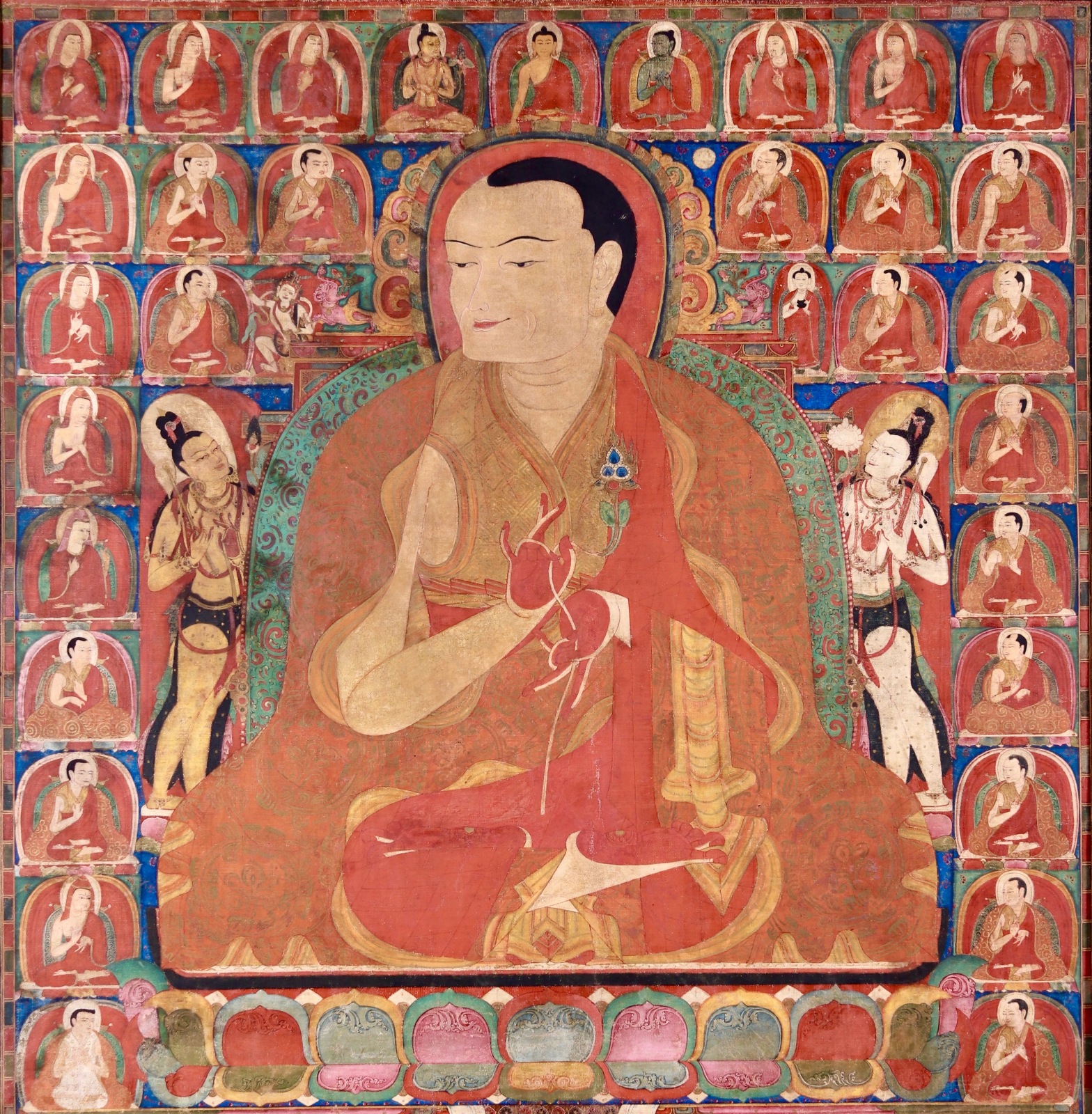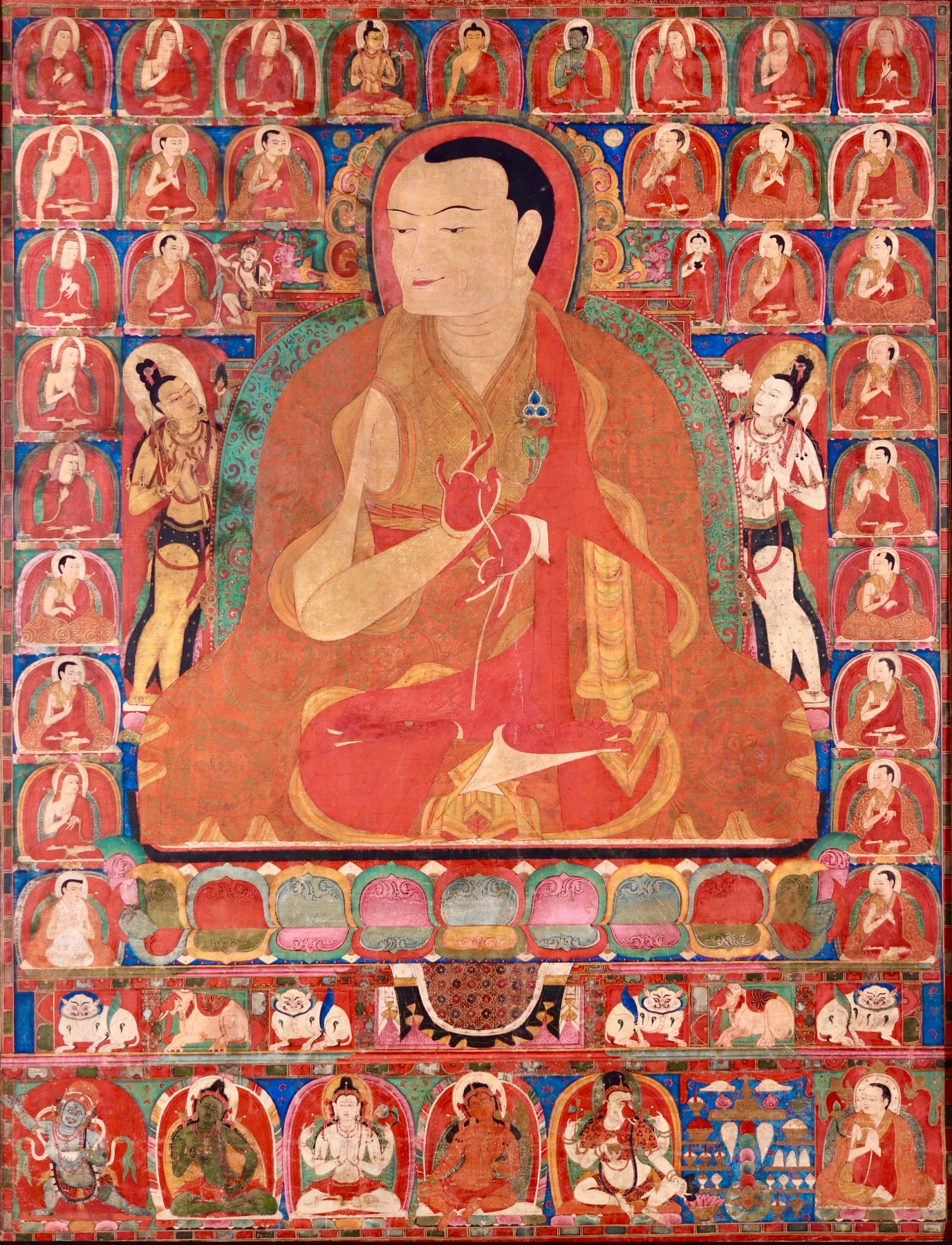
Provenance:
The Richard R. & Magdalena Ernst Collection of Himalayan Art
Sotheby's, New York, March 22, 2018, no. 920
Published:
Amy Heller, Tibetan Art: Tracing the Development of Spiritual Ideals and Art in Tibet, Milan, 1999, no. 62
Pratapaditya Pal, Himalayas: An Aesthetic Adventure, Art Institute of Chicago exhibition catalogue, 2003, no. 120
David Jackson, Mirror of the Buddha: Early Portraits from Tibet, Rubin Museum of Art, New York, 2011, p. 39, fig. 2.3
At the center of the scene is a master, identifiable by his closely cropped black hair. He is seated on a multi-colored lotus, which is supported by a throne decorated with lions and elephants and draped with an altar cloth featuring a floral pattern. The master's hands are in the dharmachakra mudra, a gesture symbolizing the turning of the Wheel of Dharma. In his hands, he holds a lotus stem which culminates in a flaming triratna, or "three jewels," a Buddhist symbol.
The master wears a red patchwork robe and a cloak made of golden, floral-patterned cloth. A green cushion with a red foliate pattern is positioned behind him, resting against a torana, or ceremonial archway, from which a makara emerges from the cosmic ocean. A halo frames the lama's face. The master is flanked by several figures. At the upper left kneels a diminutive Achala, while a figure of Amitabha is to his right, holding a patra, or bowl. Standing to the master's left is the bodhisattva Maitreya, who holds a nagakesara flower. To his right stands Avalokiteshvara, holding the stem of a white lotus.
Around the central figures, the painting is divided into registers that depict various groups and deities. In the register to the left of the main figure is an assembly of Indian panditas (scholars) wearing red caps, Tibetan monks, and a Tibetan layman in a white robe. To the right and in the registers around the halo are more Tibetan monks.
The upper register features the Buddha, Maitreya, and Indian panditas. In the lower register are powerful protector deities, including Mahakala, Vajravidarana, Shadakshari Avalokiteshvara, Vasudhara, and Ganapati. To the right, a lama in adoration is shown with his hands in the anjali mudra (a gesture of respect) and holding a lotus flower with a ratna (jewel). The scene is filled with offerings, such as conch shells, a golden stupa, fly whisks, fruit, seeds, jewels, torma (ritual cakes), and butter lamps. The entire composition is enclosed within a geometric, multi-colored, stylized lotus petal border.
This important thangka is one of the larger early paintings depicting the Tibetan masters that helped spread Buddhist doctrine during the Chidar, the “Later Diffusion” of the Buddhist faith, corresponding to the period c. 1000-1200. The figures wearing simple red cloth garments and red caps with long lappets (who fill most of the upper and left hand registers) represent the Indian gurus to whom the Tibetans turned in their quest for Buddhist teachings. Indian artistic influence is apparent throughout the painting. The principal stylistic source of early Tibetan lama portrait paintings was the aesthetic tradition of eastern India during the Pala dynasty (c. 750-1199). Compare the bulk, posture, and flowing scarf of Mahakala with the Krodha deities depicted in an eastern-Indian or Indian-influenced painting of Ushnishavijaya, and the costume and posture of the bodhisattvas in a painting of Amoghasiddhi, both in the Kronos Collection (Steven M. Kossak and Jane Casey Singer, Sacred Visions: Early Paintings from Central Tibet, New York, 1998, cat. nos. 4 and 6).
This well-published painting has accumulated commentary from a number of scholars. David Jackson has suggested the thangka dates to circa 1200 and speculates that the Indian master Atisha (982-1054) and his closest Tibetan disciple Dromtön (1005-1064) appear within the lineage and that the hierarch was thus a master of the Kadam school (David P. Jackson, Mirror of the Buddha: Early Portraits from Tibet, New York, 2011, p. 38). Dr. Pal also speculates that the thangka was painted circa 1200 for a Kadampa patron at the Kadam monastery of Narthang, founded in 1153 (Pratapaditya Pal, Himalayas: An Aesthetic Adventure, Chicago, 2003, p. 184). Amy Heller (Tibetan Art, Milan, 1999, p. 85) notes a similarity with a large thirteenth-century inscribed portrait of Zhang ston Chos kyi bLama, who was the Fifth Abbot of Narthang from 1234 to 1244 (Jane Casey Singer, “Painting in Central Tibet, ca. 950-1400,” in Artibus Asiae, Zurich, 1994, vol. 54 1/2, pp. 87-136, fig. 24).
Compare a Kadam master with hands in dharmachakra mudra and gazing to his right in the Michael J. and Beata McCormick Collection (Jackson, op. cit., p. 74, fig. 3.5). Jackson suggests that a lama holding a staff in the McCormick painting—seated in the second register down to the left, next to Sakyamuni Buddha—might be identified as Dromtön’s disciple Potowa (1027-1105), who is said in some sources to have walked with a staff. Potowa’s presence would indicate the painting portrays a Kadam lineage transmitted by Dromtön, ibid., p. 75. A lama in the present painting—seated directly above the makara to the right of the master’s halo—holds a staff in much the same manner and may also represent Potowa, supporting evidence for a Kadam attribution. The triratna on a lotus held in the master’s hands is an unusual attribute and not seen as a personal attribute elsewhere in early lineage paintings. Although the symbol commonly refers to the Buddhist trinity of Buddha, Dharma, and Sangha, it may in this instance be relevant to his school and that of the lineage depicted throughout the painting. Earlier, Amy Heller had tentatively identified the master as Drigung Kyoppa Jigten Gönpo, noting similar iconography in the portrayal of the lama and emphasis on the ratna symbol in other Drigungpa paintings ( “A Thang ka Portrait of ’Bri gung rin chen dpal, ’Jig rten gsum mgon (1143-1217)” in Journal of the International Association of Tibetan Studies 1, October 2005). The symbol is seen in the textile design of the robe and throne cloth of Drigung Kyoppa Jigten Gönpo in a thirteenth century painting, ibid., and Jackson, op. cit., p. 155, fig. 5.21, and features throughout a portrait of the Drigung hierarch in the Pritzker Collection, forming the structure of the throne, as well as the textile design of the throne cloth, ibid., fig. 5.25. No inscriptional evidence, however, categorically confirms the identity of the master in the present painting or his affiliation to a particular order. His revered status, nevertheless, is without question. Bodhisattvas standing in adoration at either side confer a state of Buddhahood upon the master. The lama’s seat is empowered and protected with mythical animals in niches below and makara in the torana above, replicating the thrones of the celestial pantheon. This richly symbolic iconographic setting illustrates the reverence in which the master was held.

